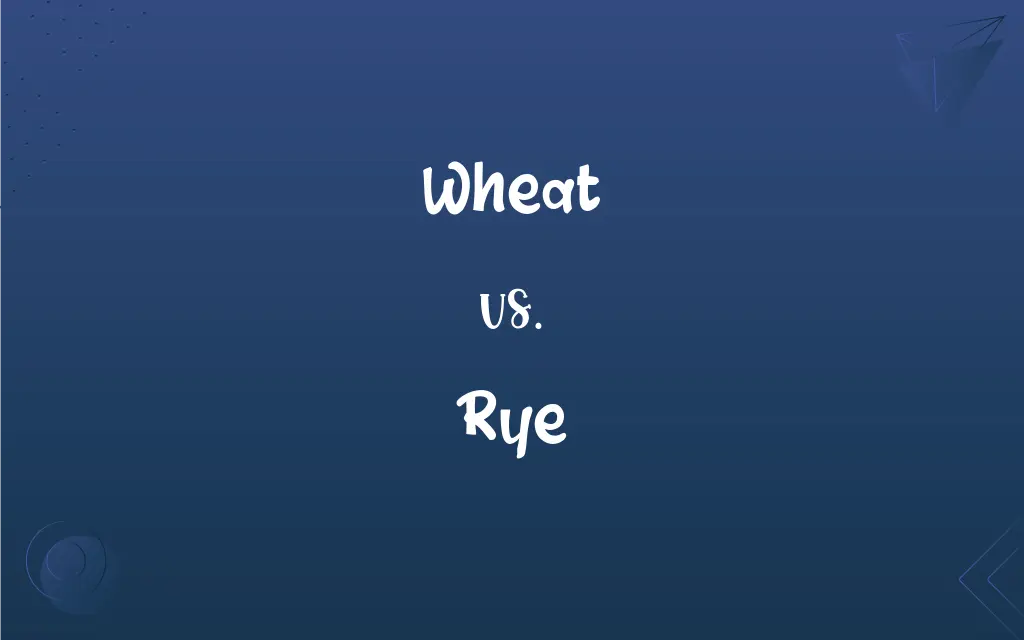Wheat vs. Rye: What's the Difference?
Edited by Aimie Carlson || By Janet White || Published on November 18, 2023
"Wheat" is a grain primarily for bread/flour, versatile in cuisine. "Rye" is a hardier grain with a distinct flavor, often in breads and whiskey.

Key Differences
"Wheat" is one of the most commonly consumed grains in the world, used in a myriad of products like bread, pasta, and pastries due to its gluten content that provides elasticity and strength. Conversely, "Rye" is a grain known for its hardiness and ability to grow in poor soils where other grains might not; it's used in making rye bread and is also a key ingredient in certain types of whiskey.
Nutritionally, "Wheat" is a good source of carbohydrates and serves as a major energy provider in many diets. It also contains vitamins, minerals, and fibers, essential for a balanced diet. "Rye" also offers numerous health benefits, being high in fiber and providing a rich source of nutrients and antioxidants, potentially aiding in weight loss and improving insulin sensitivity.
"Wheat" has a mild, slightly sweet taste, making it a versatile ingredient in a wide range of food products. In contrast, "Rye" imparts a stronger, spicier flavor and is typically used in foods that desire this distinct taste profile, such as rye bread and certain alcoholic beverages.
Regarding cultivation, "Wheat" typically requires a warm season to grow and is more sensitive to soil conditions, requiring fertile, well-drained soils. On the other hand, "Rye" is known for its ability to thrive in harsher conditions including poor, sandy soils, and colder climates.
Both "Wheat" and "Rye" can be found in whole grain forms which offer the most health benefits. Whole wheat products are more commonly available and consumed at a much higher rate worldwide, while whole rye, though less common, is often sought for its unique health benefits and flavor.
ADVERTISEMENT
Comparison Chart
Common Uses
Bread, pasta, pastries
Rye bread, whiskey
Nutritional Benefits
Carbohydrates, fiber, vitamins
Higher fiber, antioxidants
Taste
Mild, slightly sweet
Strong, spicy
Cultivation
Warm season, fertile soils
Hardier, poor soils, cold climates
Availability
More commonly available
Less common, unique uses
ADVERTISEMENT
Wheat and Rye Definitions
Wheat
Main ingredient in many types of bread.
The fresh Wheat bread smelled amazing.
Rye
A cereal grain known for its hardiness.
Rye thrives in conditions where other grains cannot.
Wheat
A cereal grain used worldwide.
The vast fields of Wheat provided a scenic view.
Rye
Distinctive in flavor.
Rye bread has a taste that's uniquely rich and spicy.
Wheat
Can be refined or whole grain.
She preferred whole Wheat for its health benefits.
Rye
Adaptable to poor soil conditions.
Farmers plant Rye in soils that are not suitable for other crops.
Wheat
Source of numerous nutrients.
Eating Wheat products contributes to a balanced diet.
Rye
A cereal grass (Secale cereale) of cool climates, widely cultivated for its grain.
Wheat
Cultivated in various species.
Different species of Wheat are used for diverse products.
Rye
The grain of this plant, ground into flour or used in making whiskey and for livestock feed.
Wheat
Any of various annual cereal grasses of the genus Triticum of the Mediterranean region and southwest Asia, especially T. aestivum, widely cultivated in temperate regions in many varieties for its commercially important edible grain.
Rye
Rye bread.
Wheat
The grain of any of these grasses, ground to produce flour used in breads, pasta, and other foods.
Rye
Whiskey made from the grains of this plant.
Wheat
(countable) Any of several cereal grains, of the genus Triticum, that yields flour as used in bakery.
Rye
A Romani man.
Wheat
(uncountable) A light brown colour, like that of wheat.
Rye
A grain used extensively in Europe for making bread, beer, and (now generally) for animal fodder.
Wheat
Wheaten, of a light brown colour, like that of wheat.
Rye
The grass Secale cereale from which the grain is obtained.
Wheat
A cereal grass (Triticum vulgare) and its grain, which furnishes a white flour for bread, and, next to rice, is the grain most largely used by the human race.
Rye
Rye bread.
Wheat
Annual or biennial grass having erect flower spikes and light brown grains
Rye
Rye whiskey.
Wheat
Grains of common wheat; sometimes cooked whole or cracked as cereal; usually ground into flour
Rye
A drink of rye.
Rye
Caraway (from the mistaken assumption that the whole seeds, often used to season rye bread, are the rye itself)
Rye
Ryegrass, any of the species of Lolium.
Rye
A disease of hawks.
Rye
A grain yielded by a hardy cereal grass (Secale cereale), closely allied to wheat; also, the plant itself. Rye constitutes a large portion of the breadstuff used by man.
Rye
A disease in a hawk.
Rye
The seed of the cereal grass
Rye
Hardy annual cereal grass widely cultivated in northern Europe where its grain is the chief ingredient of black bread and in North America for forage and soil improvement
Rye
Whiskey distilled from rye or rye and malt
Rye
Used in making certain breads and whiskey.
He enjoyed a sandwich made with Rye bread.
Rye
Offers numerous health benefits.
Incorporating Rye into your diet can improve overall health.
FAQs
What does "Rye" bread taste like?
It has a distinctive, hearty, and slightly sour taste.
Are there different types of "Wheat"?
Yes, including whole wheat, white wheat, and durum, among others.
How is "Wheat" flour used?
In baking, cooking, and as a thickener in recipes.
Is "Wheat" healthy?
In moderation, especially whole wheat, it's nutritious.
Can "Rye" help with weight loss?
Potentially, due to its high fiber content creating fullness.
Why is "Rye" considered hardy?
It grows in poorer soils and harsher climates.
Is "Wheat" a common allergen?
Yes, wheat allergies are quite common, especially due to gluten.
Does "Rye" contain gluten?
Yes, rye contains gluten, similar to wheat.
What products are made from "Wheat"?
Bread, pasta, cereals, and pastries, among others.
Is "Rye" used in beverages?
Yes, rye is a primary ingredient in some whiskeys.
Is "Rye" good for diabetics?
It can be, due to its effect on blood sugar levels.
Can "Rye" be used in pastry?
Less commonly, but its flavor can enhance certain recipes.
Can "Wheat" be eaten raw?
It's not advisable due to potential bacteria and hard texture.
What's the protein content in "Wheat"?
It varies, but it's a good protein source, especially the gluten.
Are there gluten-free "Rye" options?
No, rye naturally contains gluten.
Can "Wheat" grow in cold climates?
There are winter varieties suitable for colder regions.
How does "Rye" affect digestion?
Its high fiber content can aid digestive health.
Is "Rye" a whole grain?
Yes, rye can be found in its whole grain form.
Does "Wheat" have a high glycemic index?
Yes, especially refined wheat products.
Is "Wheat" genetically modified?
There are GM varieties, but not widely grown.
About Author
Written by
Janet WhiteJanet White has been an esteemed writer and blogger for Difference Wiki. Holding a Master's degree in Science and Medical Journalism from the prestigious Boston University, she has consistently demonstrated her expertise and passion for her field. When she's not immersed in her work, Janet relishes her time exercising, delving into a good book, and cherishing moments with friends and family.
Edited by
Aimie CarlsonAimie Carlson, holding a master's degree in English literature, is a fervent English language enthusiast. She lends her writing talents to Difference Wiki, a prominent website that specializes in comparisons, offering readers insightful analyses that both captivate and inform.






































































